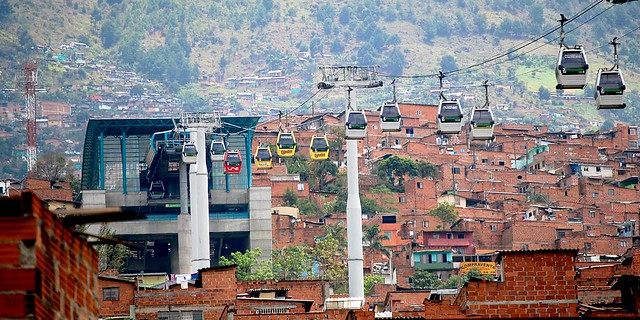The American Journal of Epidemiology recently published a report, Reducing violence by transforming neighborhoods: a natural experiment in Medellín, Colombia, which examines the effects of “neighbourhood level interventions”. In this research paper, the “intervention” studied was the implementation of the Metrocable Line K in 2004.
The paper looks at 25 neighbourhoods that were serviced by the Metrocable and 23 similar neighbourhoods from around the city that were not effected by the Metrocable. Researchers conducted a survey of these neighbourhoods in 2008, and compared them to the responses from a 2003 city-wide household survey on violence and neighbourhoods.
A cursory look at the findings indicate that the intervention neighbourhoods (those which were effected by the Metrocable) experienced a 66% faster decline in homicide rates than in the control neighbourhoods. Yet, in actuality, violence and homicide rates in both cable and non-cable areas decreased dramatically.
It should also be noted that while the government was constructing the Metrocable, they were simultaneously making other improvements to the gondola neighbourhoods, including: “additional lighting for public spaces; new pedestrian bridges and street paths; ‘‘library parks’’; buildings for schools, recreational centers, and centers to promote microenterprises; more police patrols; and a family police station next to a gondola station.”
Overall the results are encouraging for Medellín. Crime is down and community relations have improved. While this study concludes that there is statistical proof that infrastructure improvements can help decrease violence, it also clearly states that other factors could have influenced the results.
Medellín was lucky to have had a major government infrastructure intervention happen just a year after PREVIVA, the city-wide survey on violence, was conducted. Even without a survey, it will be interesting to see if there are any actual or perceived effects from the 2011 gondola system in Rio de Janeiro, and the proposed system in La Paz.
If you would like to read the full study, it is available here.


1 Comment
Interesting story, but not sure if it a “non story” or not. Seems like there were a LOT of variables.
However, having a lot of people taking this very public and visible right of way could have had an impact. I do wonder if “civic pride” has any affect on crime as well.
Another answer could be based on the “broken windows” theory. ie., If you don’t fix windows, what else do you not care about and the converse which the NYPD used under Guliani in NYC when he cracked down on all crime, even the petty crime like the guys shaking you down in the streets to clean your window and get paid for it…
The theory that if NYPD cares that much about “petty crime” then the more serious criminals will think “shit, they must really crack down on more serious crimes.”